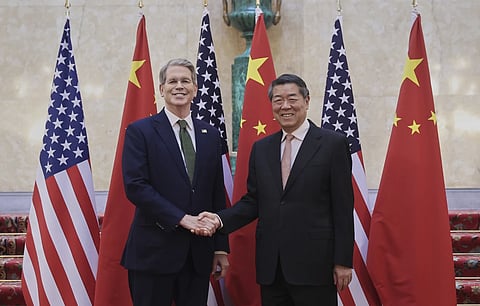

In a significant development signalling a thaw in trade tensions, China on Friday announced it would review and approve export applications for controlled items in line with its regulations, while the United States confirmed it would roll back several restrictive measures targeting Chinese exports. The move follows a recent round of trade talks between the two economic giants, which concluded earlier this month in London.
China’s Ministry of Commerce said both sides have been in “close communication” since the two-day discussions, and that the consensus reached in London is now being implemented, the South China Morning Post reported. “We hope that the US side will work with China, in line with the important consensus and requirements put forward during the June 5 talk between the two presidents,” the ministry said in a statement.
US President Donald Trump on Thursday said a trade agreement had been “signed” with China a day earlier, although he did not disclose any specifics. “We just signed with China yesterday… In the China deal, we’re starting to open up China,” he said during an event at the White House.
While details remain limited, the agreement is expected to address critical export controls, including those related to semiconductors and rare earth elements – both flashpoints in earlier rounds of trade friction. “If they have removed those controls, then it is a major breakthrough,” said Jayant Menon, senior fellow at the ISEAS-Yusof Ishak Institute in Singapore. “These were things that were tightened under the Biden administration. If they are reversed, this is actual progress in trade liberalisation.”
The US Commerce Secretary, Howard Lutnick, separately told reporters the deal formalises terms agreed in earlier negotiations. In an interview with Bloomberg, he confirmed that China had committed to supplying rare earths, and that Washington would lift its “countermeasures” once this commitment is met.
Rare earth elements are vital to the manufacture of advanced technologies, including those used in the defence sector. China’s dominance in refining these minerals had become a significant leverage point in the trade war. Ministry spokesman He Yadong confirmed that Beijing has already approved “a certain number” of export applications and will continue to strengthen the review process for compliant requests. China, he added, is open to enhanced communication on export controls and will “actively promote” lawful trade facilitation.
The statements from both sides suggest a desire to maintain a diplomatic course after months of uncertainty. “As far as I am aware, this was a verbal confirmation of progress since earlier discussions in Europe, rather than a new breakthrough,” said Lynn Song, chief economist at ING. “Nonetheless, it is encouraging to see steps in a productive direction. It remains to be seen how fast companies adapt to the lifting of export controls.”
Menon also struck a cautious note, stressing the need for greater clarity. “What we’ve learned is nothing is guaranteed – anything can be reversed at any time,” he said. “We’ve had lots of lose-lose outcomes lately, so this is a rare case of a win-win.”
The recent moves are part of a broader US push to finalise trade arrangements with multiple partners. Trump indicated that a “very big” deal with India may be next, while Lutnick said the US is aiming to seal trade agreements with 10 countries in the coming weeks. A 90-day pause in tariff hikes, declared on April 2, is due to expire on July 9 unless new bilateral terms are finalised.
The easing of tensions follows a pivotal phone call between Presidents Xi Jinping and Trump, which broke a months-long deadlock and paved the way for the Geneva agreement last month. That deal had aimed to stabilise relations amid escalating disputes over export restrictions, visa policies, and sensitive technology flows.
While markets are likely to welcome the apparent breakthrough, the full impact will depend on the scope and pace of implementation, the newspaper said. The world’s two largest economies appear to be back on the path to cautious engagement – but with plenty of unresolved issues still on the table.